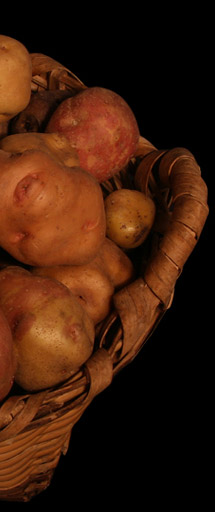Introduction.
A variety treasure , as some specialists defined it, has been a study object for some years, now ready for the great takeoff of the so longed Certification of Origin, that so much the Association of Ancient Canarian Potato has fought for. This Association is formed and represented by farmers, cooperatives, engineers, vinegrowers, investigators, restaurateurs and fans in general. Today the named ancient canarian potatoes, originally from Peru and Bolivia , are potatos arrived at our Archipiélago newly-found America . There are data pointing to its presence in the XVIth century. B ut it's probable that they were known on the islands before 1567, date taken as firm existing a document in the presence of the notary Lorenzo Palenzuela who indicates the departure in a Dutch vessel from Las Palmas harbour, and bound for Antwerp .
The set of varieties we call ancient potatos (spp andígena ) extends about 15 types, from which only some are known, linked to the traditional gastronomy. In the last years famous restaurateurs and gastronomy reviewers were seeing those varieties, showing their admiration. The Canarian potato have entered into the new kitchen in that environment of rediscovery. Up t o the ´50 and ´60 the Canarian consumer mainly knew how to recognize the different kinds of potatoes. That culture has been extinguishing over the years. Incorporating more productive varieties of short cycle, has been relegating traditional potatoes , even though always have been recognised and have been related kitchen's dishes that prove to be more traditional and exquisite to, requesting them specially for family foods: Christmas's celebrations, popular parties, etc. 
The Association's right now old ambition, is just a step away from becoming reality.
These jewels of Our agriculture have been preserved, during centuries to our days, thanks to the effort and our peasants's endurance, grown and pampered, like a great legacy, generation upon generation. Unique in the European community, due to his exceptional characteristics, its economic, landscape and environmental importance, it deserves the support of all of us for his conservation, improvement and an adequate commercialization, avoiding thus its deterioration and disappearance of our fields.
It is attempted to recover the crop rotation (isolated at some midland zones), sanitation of varieties and interchanges among farmers. The association has acted with a true altruism, because they think the true main character of all of this is the potato, and without any doubt those farmers who have preserved it for so much time.
Canary Islands and in particular Tenerife, must search not only for agricultural alternatives, but proposals of use and management of rural spaces in agreement to an agriculture of quality and interest to the consumer, and definitively a guaranty of future for the midland agriculture.
Proposals and solutions assumed in each situation, must be based in a particularized analysis of the involved natural, economic and social parts.
This great step, for the creation of the Certification of Origin, must lead to integrate the professional with knowledge of basics, of possibilities and of its beginning within the standarts of a quality agriculture.
The recuperation and temper the Certificate of Origin will suppose a sustainable development, upkeep of the landscape, and definitively, creation of surroundings where quality of life a goal to achieve.
We cannot let the Ancient potatos to be just a memory, hence this Web goes in enriching sense and as incentive by the knowledge of a hallmark toward the consumer. The Association and the Regulating Council of the Certification of Origin will be in charge of the fomentation of production for what they will transfer those necessary inventions for a sustainable, integral and economically profitable cultivation.

Sources:
• Propuesta de Reglamento de la denominación de origen “Papas antiguas de Tenerife”, Tomo I, (Gil et. al, dic. 1999)
• Papas Antiguas de Canarias.
• Asociación de Papas Antiguas de Canarias.
• A cuantos se han manifestado por el interés de este cultivo, para su reconocimiento y supervivencia...
• Las fotografías de la Web son, en su mayor parte, del fotógrafo y amigo Roberto de Armas (variedades de papas, paísajes, etc.) y de la Web (Papas Antiguas de Canarias)...
• Las fotografías de las variedades Corraleras, en sección variedades-fichas, son del Cabildo Insular de La Palma
-----------------------------------------



